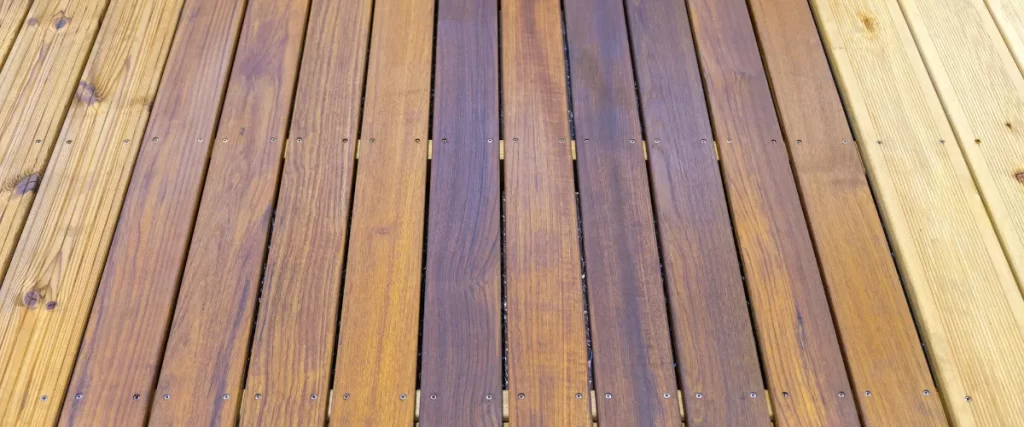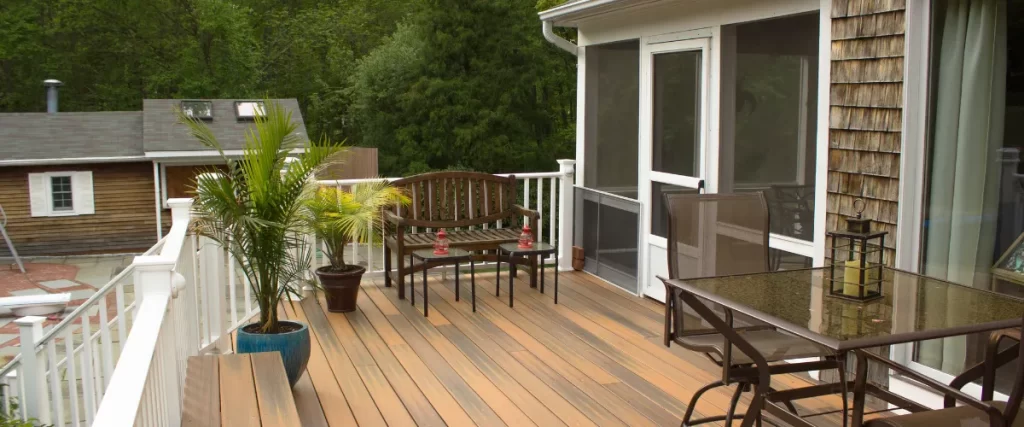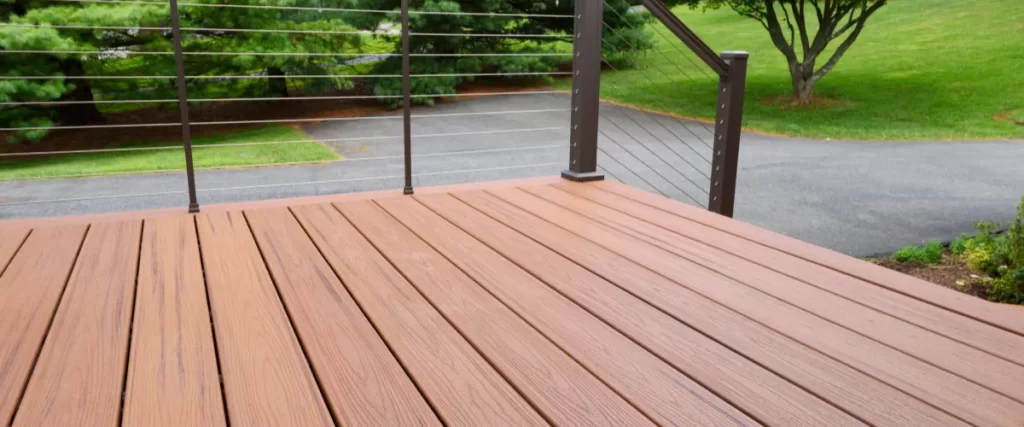Building a deck is an exciting way to expand your outdoor living space. But if you live in an area prone to wildfires or just want an extra layer of safety, choosing fire-resistant materials for your deck is a smart move. Not only do these materials provide peace of mind, but they also ensure your deck stands the test of time.
Let’s dive into the world of fire-resistant deck materials, why they matter, and which options might be the best fit for your home.

Why Choose Fire-Resistant Materials?
Your deck isn’t just a part of your home—it’s an investment in your lifestyle and property value. Fire-resistant materials are designed to withstand heat and flames, giving you extra protection in case of emergencies. Here’s why they’re worth considering:
- Enhanced Safety: Fire-resistant materials can slow the spread of flames, protecting your home and giving you more time to react in a worst-case scenario.
- Durability: These materials are often stronger and longer-lasting, reducing the need for repairs or replacements.
- Peace of Mind: Knowing your deck is built to handle extreme conditions helps you relax and enjoy your outdoor space without worry.
Top Fire-Resistant Deck Materials
There are several fire-resistant decking materials to consider. Let’s break down the most popular options:
1. Composite Decking
Composite decking is made from a mix of wood fibers and recycled plastic, creating a durable, low-maintenance material. Many composite decking brands now offer fire-resistant options.
Why It’s Great:
- Doesn’t ignite easily.
- Resistant to rot, mold, and warping.
- Comes in a variety of colors and textures.
What to Keep in Mind:
- It can be pricier than wood.
- Some brands offer better fire resistance than others, so check the fire rating before buying.
2. Aluminum Decking
Aluminum decking is one of the most fire-resistant materials you can choose. It’s non-combustible, lightweight, and requires almost no maintenance.
Why It’s Great:
- Completely fireproof.
- Resistant to rust, rot, and insects.
- Reflects heat, keeping the surface cooler in hot weather.
What to Keep in Mind:
- It has a modern, industrial look that may not suit every home’s aesthetic.
- Higher upfront cost compared to other materials.
3. Fire-Treated Wood
Fire-treated wood is natural wood that has been chemically treated to reduce its flammability. It’s an excellent option for homeowners who love the look of traditional wood but want added safety.
Why It’s Great:
- Maintains the classic beauty of natural wood.
- Treated to resist ignition and slow fire spread.
- Available in various wood types, including cedar and redwood.
What to Keep in Mind:
- Requires periodic reapplication of fire-retardant chemicals.
- Can be less durable than composite or aluminum.
4. Concrete Decking
Concrete decking is a strong, fireproof option that works well for ground-level decks. It’s a great choice for modern or industrial-style homes.
Why It’s Great:
- Completely non-combustible.
- Long-lasting and highly durable.
- Minimal maintenance required.
What to Keep in Mind:
- Limited design flexibility compared to other materials.
- Installation can be labor-intensive and costly.
5. PVC Decking
PVC (polyvinyl chloride) decking is made entirely of plastic, making it resistant to fire, moisture, and insects. It’s a versatile option for homeowners looking for both safety and style.
Why It’s Great:
- Highly resistant to fire and moisture.
- Lightweight and easy to install.
- Comes in various colors and styles to mimic wood.
What to Keep in Mind:
- Can feel less natural underfoot compared to wood.
- Prone to scratching if heavy furniture or sharp objects are dragged across it.

How to Choose the Best Material for Your Deck
With so many options, how do you decide which fire-resistant material is right for your home? Here are some tips to help you choose:
- Consider Your Budget: While fire-resistant materials like aluminum and composite may have a higher upfront cost, they often save money in the long run with fewer repairs and lower maintenance.
- Think About Maintenance: Some materials, like PVC and composite, require very little upkeep, while fire-treated wood may need regular treatment to maintain its fire resistance.
- Match Your Home’s Style: If you love a natural, rustic look, fire-treated wood might be your best bet. For a sleek, modern feel, aluminum or concrete could be ideal.
- Check Local Codes: Some areas have specific fire safety regulations for decks. Be sure to choose materials that meet or exceed these standards.
Upgrades to Pair with Fire-Resistant Deck Materials
When building or upgrading your deck with fire-resistant materials, consider adding these features for even more safety and functionality:
- Fire-Resistant Railings: Opt for metal or composite railings to complement your fire-safe deck.
- Outdoor Lighting: Install LED lighting that won’t generate excessive heat.
- Built-In Seating: Choose fire-resistant materials for permanent seating options.
- Pergolas or Shade Structures: Look for fire-resistant fabrics or metal frames for added safety and style.
Comparing Fire-Resistant Deck Materials
Each fire-resistant decking material has its own unique benefits and challenges. To help you decide, let’s take a closer look at how these materials compare:
Cost
Cost is often one of the biggest factors when choosing decking materials. Fire-treated wood is typically the most affordable option, making it a great choice for budget-conscious homeowners. Composite decking is moderately priced and offers excellent long-term value due to its durability and low maintenance. Aluminum and concrete are the most expensive options upfront, but their incredible longevity and fireproof qualities often make them worth the investment.
Durability
When it comes to durability, aluminum decking takes the top spot. It’s resistant to fire, rust, and weather, making it an excellent long-term choice. Composite decking also performs well, with resistance to moisture, insects, and cracking. Fire-treated wood is durable if maintained properly but may require more frequent upkeep to ensure its fire resistance. Concrete is incredibly strong and can last for decades, but it may develop cracks over time if not installed correctly.
Aesthetic Appeal
Aesthetic preferences play a significant role in deck material selection. Fire-treated wood is ideal for those who want the natural beauty and warmth of wood. Composite decking offers a wide variety of colors and textures that mimic real wood, giving you the best of both worlds. Aluminum and concrete decks have a modern, industrial look that may not suit every home but are perfect for contemporary styles.
Fire-Resistance Ratings Matter
When choosing materials, it’s important to look at fire-resistance ratings. These ratings indicate how well a material can withstand fire or heat exposure. Class A ratings are the highest and offer the best protection, making them an ideal choice for decks in high-risk areas. Composite, aluminum, and concrete decking materials often fall into this category, while fire-treated wood can achieve a Class A rating if properly maintained.
Tips for Maintaining Fire-Resistant Decks
While fire-resistant materials are built to last, regular maintenance ensures they stay in top condition. Here are some easy tips to keep your deck looking great and performing well:
- Clean Regularly: Sweep debris and clean the surface with mild soap and water to prevent buildup that could pose a fire risk.
- Inspect Annually: Check for any signs of wear, such as cracks or loose fasteners, and address them promptly.
- Reapply Treatments: If you’ve chosen fire-treated wood, reapply fire-retardant chemicals as needed to maintain its protective qualities.
- Trim Vegetation: Keep plants and trees around your deck well-trimmed to reduce fire hazards.
Building a Fire-Resistant Outdoor Lifestyle
In addition to using fire-resistant materials, consider designing an outdoor space that prioritizes safety. Choose fire-safe furniture and decor made from metal, treated wood, or other non-flammable materials. Add features like stone or concrete planters to enhance the look of your space while adding a layer of fire protection.
A fire pit or outdoor fireplace can also add charm to your deck, but ensure it’s made from fire-resistant materials and is positioned safely away from flammable surfaces. Combining these thoughtful touches with fire-resistant decking materials creates an outdoor living space that’s both beautiful and secure.
FAQs About Fire-Resistant Deck Materials
Q: Are all composite decks fire-resistant?
Not all composite decks are fire-resistant. Check the fire rating before purchasing, as some brands offer specific fire-resistant lines.
Q: Can I make my existing deck fire-resistant?
Yes, you can upgrade your existing deck with fire-resistant treatments or replace components like boards and railings with fire-safe materials.
Q: How much more do fire-resistant materials cost?
The cost varies by material. Fire-resistant options like aluminum and composite are typically more expensive than untreated wood but offer long-term value.
Q: Do fire-resistant decks still need maintenance?
Yes, while fire-resistant materials like aluminum and composite require minimal upkeep, they still benefit from regular cleaning to maintain their appearance.

Protect Your Deck with Riverview Decks
A fire-resistant deck is more than a safety feature—it’s a smart investment in your home and outdoor lifestyle. Whether you’re starting from scratch or upgrading an existing deck, choosing the right materials can make all the difference.
At Riverview Decks, we specialize in crafting beautiful, durable, and fire-safe decks tailored to your needs. Ready to take the next step? Contact us today at (865) 801-4545 to kickstart your deck building project!

